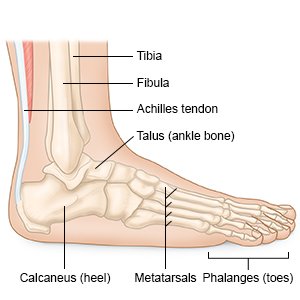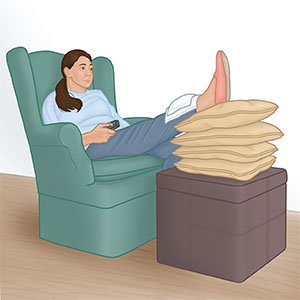Tarsal Tunnel Release
Medically reviewed by Drugs.com. Last updated on Aug 4, 2025.
AMBULATORY CARE:
What you need to know about tarsal tunnel release:
Tarsal tunnel release is surgery to relieve pain and numbness from tarsal tunnel syndrome. The tarsal tunnel is between the bump on the inside of your ankle and ligaments stretched across your foot. Surgery takes pressure off a nerve in the tarsal tunnel.
 |
How to prepare for surgery:
- Your surgeon will tell you how to prepare. He or she may tell you not to eat or drink anything after midnight on the day of surgery. Arrange to have someone drive you home when you are discharged from the hospital.
- Tell your surgeon about all medicines you currently take. He or she will tell you if you need to stop any medicine for surgery, and when to stop. He or she will tell you which medicines to take or not take on the day of surgery.
- Tell your surgeon about all your allergies, including to medicines or anesthesia.
- You may need to have nerve tests, an x-ray, or other tests to check your ankle. If you have diabetes, your A1c and blood sugar level may need to be checked.
What will happen during surgery:
Your surgeon may do open or endoscopic surgery. Open means he or she will make 1 incision in your ankle. Endoscopic means he or she will make 2 or 3 small incisions. Surgery will be done with tools put into the small incisions.
- You may be given general anesthesia to keep you asleep and free from pain during surgery. You may instead be given local anesthesia to numb the surgery area. With local anesthesia, you may still feel pressure or pushing during surgery, but you should not feel any pain. A band may be put around your leg to prevent bleeding.
- Your surgeon will cut a ligament in your ankle. This will relieve pressure being put on the tibial nerve. He or she may need to remove a bony growth or cyst causing your symptoms.
- An open surgery incision will be closed with stitches. Endoscopic incisions will be closed with medical tape. A bandage will be placed over the surgery area to prevent infection.
What to expect after surgery:
- Medicines may be given to prevent or treat pain or a bacterial infection.
- You will need to move around after surgery to help prevent blood clots. You will not be able to put weight on your ankle, so you may be shown exercises to do in bed.
- You may not be able to put weight on your ankle until the surgery area heals. This may take 2 or 3 weeks. A splint will be put on your ankle to protect it and prevent movement. Then a physical therapist will teach you range of motion exercises for your ankle. You may also be able to use a walking boot so you can start to put weight on your ankle.
Risks of tarsal tunnel release:
You may bleed more than expected or develop an infection. A bone, artery, or nerves near the surgery area may be damaged. Surgery may not fully relieve the tarsal tunnel. You may continue to have pain or numbness in your ankle, foot, or toes. You may develop a condition called plantar fasciitis that causes pain in your heel.
Call your local emergency number (911 in the US) if:
- You have sudden chest pain or trouble breathing.
- You cough up blood.
Related medications
Seek care immediately if:
- You have pain in the surgery area longer than you were told to expect.
- Your surgery area is bleeding or drains fluid.
- You feel dizzy.
Call your doctor if:
- Your calf muscles ache.
- You have signs of an infection, such as redness, swelling, or pus.
- You have new or worsening symptoms.
- You have a fever.
- You have questions or concerns about your condition or care.
Medicines:
You may need any of the following:
- Prescription pain medicine may be given. Ask your healthcare provider how to take this medicine safely. Some prescription pain medicines contain acetaminophen. Do not take other medicines that contain acetaminophen without talking to your healthcare provider. Too much acetaminophen may cause liver damage. Prescription pain medicine may cause constipation. Ask your healthcare provider how to prevent or treat constipation.
- Blood thinners help prevent blood clots. Clots can cause strokes, heart attacks, and death. Many types of blood thinners are available. Your healthcare provider will give you specific instructions for the type you are given. The following are general safety guidelines to follow while you are taking a blood thinner:
- Watch for bleeding and bruising. Watch for bleeding from your gums or nose. Watch for blood in your urine and bowel movements. Use a soft washcloth on your skin, and a soft toothbrush to brush your teeth. This can keep your skin and gums from bleeding. If you shave, use an electric shaver. Do not play contact sports.
- Tell your dentist and other healthcare providers that you take a blood thinner. Wear a bracelet or necklace that says you take this medicine.
- Do not start or stop any other medicines or supplements unless your healthcare provider tells you to. Many medicines and supplements cannot be used with blood thinners.
- Take your blood thinner exactly as prescribed by your healthcare provider. Do not skip a dose or take less than prescribed. Tell your provider right away if you forget to take your blood thinner, or if you take too much.
- Take your medicine as directed. Contact your healthcare provider if you think your medicine is not helping or if you have side effects. Tell your provider if you are allergic to any medicine. Keep a list of the medicines, vitamins, and herbs you take. Include the amounts, and when and why you take them. Bring the list or the pill bottles to follow-up visits. Carry your medicine list with you in case of an emergency.
Self-care:
- Rest as needed. Start to do more each day, as directed.
- Apply ice on the surgery area. Apply ice for 15 to 20 minutes every hour or as directed. Use an ice pack, or put crushed ice in a plastic bag. Cover it with a towel before you apply it. Ice helps prevent tissue damage and decreases swelling and pain.
- Elevate your ankle to relieve swelling and pain. Raise your ankle above the level of your heart as often as possible during the day. Prop your lower leg on pillows or blankets to keep it elevated comfortably.

- Ask when you can return to your regular activities. Your healthcare provider will tell you when it is okay to drive and to return to work or other activities.
- Go to physical therapy, if directed. A physical therapist will teach you range of motion exercises for your ankle.
Care for the surgery area:
Your healthcare provider will tell you when to remove the bandage after surgery. He or she will give you specific care instructions for your surgery area. The following are general guidelines to follow:
- Keep the surgery area dry. Do not swim or soak your foot in any water until your healthcare provider says it is okay. Your provider will tell you when it is okay to take a shower. If you have stitches, you may need to wait a few days after your stitches are removed. First cover the surgery area with a plastic bag and tape it closed to keep water out.
- Check the surgery area for signs of infection. Examples include redness, swelling, or pus. Check the area every day.
Follow up with your doctor or surgeon as directed:
You may need to return to have your surgery area or ankle checked. You may also need to have stitches removed. Write down your questions so you remember to ask them during your visits.
© Copyright Merative 2025 Information is for End User's use only and may not be sold, redistributed or otherwise used for commercial purposes.
The above information is an educational aid only. It is not intended as medical advice for individual conditions or treatments. Talk to your doctor, nurse or pharmacist before following any medical regimen to see if it is safe and effective for you.
Further information
Always consult your healthcare provider to ensure the information displayed on this page applies to your personal circumstances.
